Menus
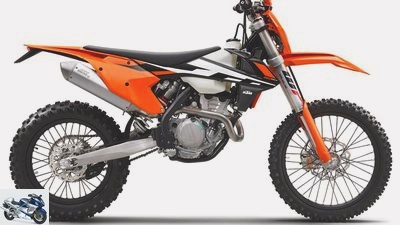
StudioMAC
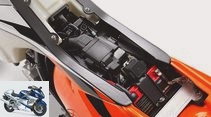
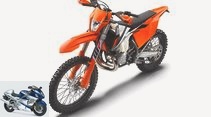
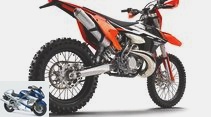
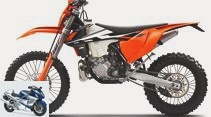
8th photos

StudioMAC
1/8
KTM 250 EXC-F.
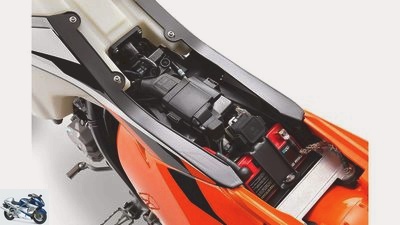
StudioMAC
2/8
The central electrical system under the seat, the Li-ion battery only weighs half a kilogram.
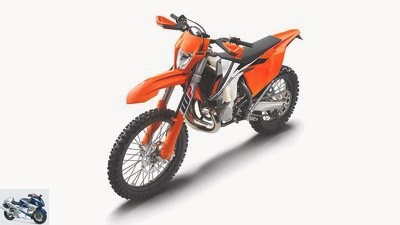
StudioMAC
3/8
KTM 250 EXC.

StudioMAC
4/8
KTM 250 EXC.
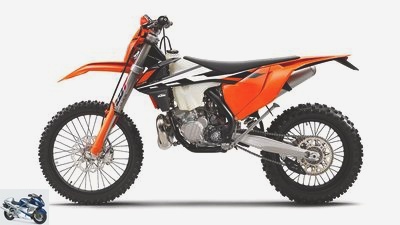
StudioMAC
5/8
KTM 250 EXC.
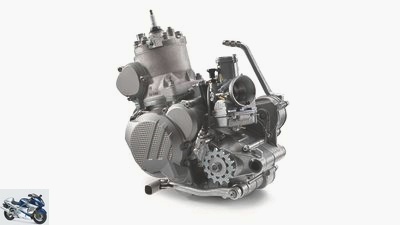
StudioMAC
6/8
After a long time (1992), KTM designed a completely new quarter-liter two-stroke including a balance shaft for the first time. The electric starter, which was previously flanged on, is now integrated into the housing below the crankshaft. For now it stays with the carburetor, injection comes later.
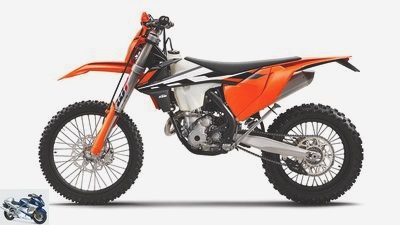
StudioMAC
7/8
All four-stroke engines also have more compact and lighter engines that are housed in a new chassis.
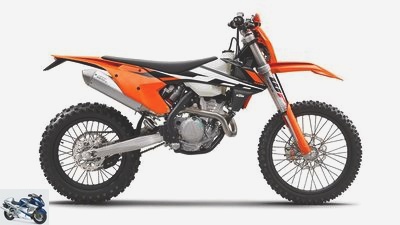
StudioMAC
8/8
KTM 250 EXC-F.
2017 KTM sport enduros in an individual test
Continue in two-quarter time
After the Austrians put a completely new generation of crossers on the bikes for the current model year, the enduros are up for 2017.
NAfter the Austrians have put a completely new generation of crossers on their bikes for the current model year, it’s the turn of the Enduros for 2017. Everything is new, from the suspension to the frame and bodywork to the engines. The new EXC enduros were recently presented in Les Comes / Spain and will be on the market in the next few weeks.
Buy complete article
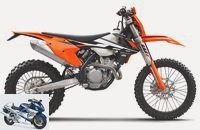
2017 KTM sport enduros in an individual test
Continue in two-quarter time
KTM two-stroke lifts smooth running to an unknown level
The new KTM two-stroke lifts the smoothness to a previously unknown level, it is finely controllable and very clean on the gas. Any bite from previous two-stroke engines has disappeared. The only small downer is that the engine pushes a little when the throttle is closed. KTM is still trying to get this under control by optimizing the carburetor set-up. But with the new qualities, the two-stroke engines, which have already been popular up to now, should definitely get another boost.
The chassis is also set up quite smoothly, good on rocky terrain. In contrast to the air-sprung cross forks, the fork continues to work with steel springs in both bars, while the rebound and compression stages are divided. The response behavior and the traction on the front wheel are good, the Open Cartridge fork only reaches its limits with a hard, cross-like driving style. The chassis was also diligently developed. The now lighter frame has a lower flexural stiffness to improve the driving experience. The torsional stiffness, however, has been increased for better driving stability. The shock absorber has moved more towards the center, making the whole chassis less asymmetrical. KTM continues to hold on to the leverless, directly hinged PDS strut, while the Husqvarna derivatives have a lever system. Rightly so, because with the new chassis you don’t miss more progression, responsiveness or traction.
Four-stroke engine also completely revised
Everything is new with the four-stroke models too. The 2017 engine generation is based on the current cross engines, making it lighter and more compact. Let’s focus on the 250, which has the greatest differences to its predecessor. The new motor delivers more pressure at the bottom, but also rotates more freely at the top. A recommended extra is the map switch, because the differences between the mappings are clearly noticeable and meaningful, and it also includes traction control that is helpful and effective in the enduro sector. As with the Crossers, however, the 250 has the greatest drag torque of the four-stroke range, which makes the load changes a little harder and allows the fork to dip deeper in push mode.
There are great advances in ergonomics and handling. The new machines are not only lighter, but also narrower and more compact, moving the reduced mass closer to the center of gravity. This is particularly beneficial for handling in difficult terrain. A short fling to the 350: Naturally, it offers noticeably more pressure in all speed ranges, runs very cultivated and with less drag torque. A fantastic motor for the hobby enduro rider who also benefits from the optional traction control on slippery surfaces. The same applies to the two large four-stroke 450/500 EXC-F, which have not been tested here, as to the smaller models; they too received new engines, chassis and components.
2017 – what’s new?
StudioMAC
After a long time (1992), KTM designed a completely new quarter-liter two-stroke engine including a balance shaft for the first time. The electric starter, which was previously flanged on, is now integrated into the housing below the crankshaft. For now it stays with the carburetor, injection comes later.
engine:
- Four-stroke more compact and lighter, derived from the cross engines
- 250/300 two-stroke engine completely redesigned with balancer shaft and integrated electric starter
- Optional map switch for various engine mappings and traction control
landing gear:
- Frame lightened by 300 g with higher torsional stiffness and reduced bending stiffness
- WP shock absorber designed more progressively with double pistons and 600 g lighter
- WP fork XPlor 48 with open cartridge, steel springs and separate rebound / compression stage in the fork legs
- Silencer according to the FIM noise limit, but shorter and closer to the center of gravity
- New bodywork slimmer
- Weight reduced by up to five kilograms
Related articles
-
Comparison test: eleven current sport enduros
de Diego Comparison test: eleven current sport enduros 450 sports enduro Never before have eleven sport enduros of a single displacement class had to…
-
2017 travel enduros from BMW, Ducati, Honda, KTM and Triumph in a comparison test
Rivas 50 photos Rivas 1/50 2017 travel enduro in comparison test. Rivas 2/50 BMW, Ducati, Honda, KTM and Triumph in the battle for control of the travel…
-
Husqvarna sport enduros of the model year 2017 in the driving report
Husqvarna 30th photos Husqvarna 1/30 Husqvarna sport enduros, four-stroke models 2017. Husqvarna 2/30 The Husqvarna model range comes off the assembly…
-
Comparison test: The five newest 450cc sport enduros
Comparison test: sports enduro bikes The five newest 450 enduros in the test If you want to fly with the big ones, you also have to gain a…
-
Comparative test of 450 cc sport enduro bikes
Llurba Comparative test of 450 cc sport enduro bikes All nine D. he highest sales figures, the fastest lap times, the highest priority – the 450 class is…
-
Yamaha MT-07 model year 2017 and 2018 test
Arturo Rivas 16 pictures Arturo Rivas 1/16 The Yamaha MT-07 models from 2017 and 2018 in a comparison test. Arturo Rivas 2/16 2018: The damper …
-
Comparison test of mid-range sport enduros 2018
Marco Campelli 24 pictures Marco Campelli 1/24 Honda CREF 400 RX, Husqvarna FE 350, KTM 350 EXC-F and Sherco 300 SEF-R Factory in a comparison test. Marco …
-
Test and technology: individual test BMW F 800 GT
Bilski Single test: BMW F 800 GT The new sports tourer from BMW in the test Freedom on two wheels, which also means having the choice between traveling…
-
Gargolov 29 photos Ducati 1/29 Ducati 1198 S.. Ducati 2/29 Ducati 1198 S.. Ducati 3/29 Ducati 1198 S.. Ducati 4/29 Ducati 1198 S.. Ducati 5/29 Ducati…
-
Alpen Masters 2017 travel enduros put to the test
fact 22nd photos fact, r-photography.info 1/22 Alpenmasters 2017 Part 2 – Adeventure. fact, r-photography.info 2/22 Alpenmasters 2017 Part 2 -…